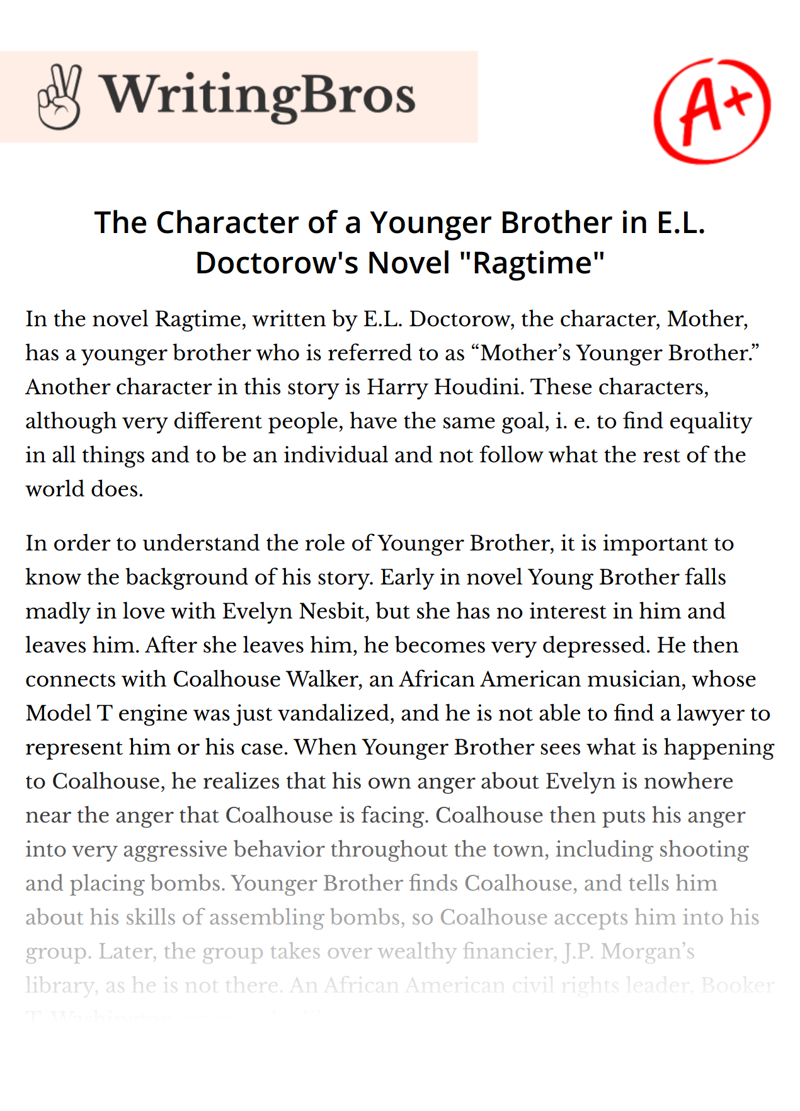The Character of a Younger Brother in E.L. Doctorow's Novel "Ragtime"

In the novel Ragtime, written by E.L. Doctorow, the character, Mother, has a younger brother who is referred to as “Mother’s Younger Brother.” Another character in this story is Harry Houdini. These characters, although very different people, have the same goal, i. e. to find equality in all things and to be an individual and not follow what the rest of the world does.
In order to understand the role of Younger Brother, it is important to know the background of his story. Early in novel Young Brother falls madly in love with Evelyn Nesbit, but she has no interest in him and leaves him. After she leaves him, he becomes very depressed. He then connects with Coalhouse Walker, an African American musician, whose Model T engine was just vandalized, and he is not able to find a lawyer to represent him or his case. When Younger Brother sees what is happening to Coalhouse, he realizes that his own anger about Evelyn is nowhere near the anger that Coalhouse is facing. Coalhouse then puts his anger into very aggressive behavior throughout the town, including shooting and placing bombs. Younger Brother finds Coalhouse, and tells him about his skills of assembling bombs, so Coalhouse accepts him into his group. Later, the group takes over wealthy financier, J.P. Morgan’s library, as he is not there. An African American civil rights leader, Booker T. Washington, goes to the library and speaks with Coalhouse very sternly of his actions. Coalhouse replies by saying “we might both be servants of our color, who insist the truth of our manhood and the respect it deserves (Doctorow, 282).” Everyone in the room, including Younger Brother, heard this intense conversation. Coalhouse ends by saying he will leave if he can have his Model T engine back in the condition it was in before it was vandalized. As he said this, Washington could see the pain in Coalhouse’s eyes as he spoke. After Coalhouse gets shot trying to escape the police, Younger Brother is rewarded with his Model T engine and takes it to numerous places until settling in Mexico. He joins a Mexican group by showing them his bomb assembling skills, as he did with Coalhouse.
The background is significant because it shows that mysterious Younger Brother was an egalitarian who wanted equal rights for all people, unlike his white, disrespectful father. He wanted to break the barrier between blacks, whites, and other races, and his actions throughout this story show his determination to do so. He saw the discrimination that Coalhouse faced, and his role/purpose was to be the neutralizer to help fix this division. This role enabled him to personally see the pain that minorities have to go through in our country.
Harry Houdini, a famous escape artist, comes in and out of this novel, but aside from his tricks and daredevilish acts, he has a “personal obsessive goal”, which is his interest in communicating with the dead. This obsession began after the death of his mother, when before she took her last breath, she said Harry’s name. Ever since then, he wondered what she was trying to tell him. At this point in time, Harry is no longer performing shows and tricks because the death of his mother has put him into a slump, but as he looks into ways to communicate with the dead he becomes more vibrant and happy. Doctorow suggests that Houdini is finding the true meaning and values of things that the mainstream people might not see. This personal goal of his was put into this story for one of the same reasons that Young Brother stood up for Coalhouse, and that is to find purpose and equality in all things.
Both of these characters have a true passion for being individuals and not listening to the world’s message. Young Brother and Harry want to find the true purpose and value behind individuals, and because of this, their purpose is revealed as they show others that there is always more to the story than what appears on the surface. This is a lesson from which we can all learn.
Cite this Essay
To export a reference to this article please select a referencing style below

